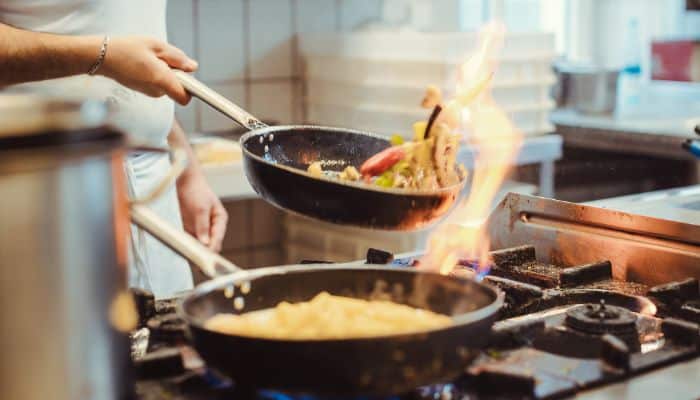Managing Kitchen Fires: 5 Things All Restaurateurs Should Know
Every restaurateur has a story about cooking gone awry — times when operations are so fast and one mishap leads to open flames in the kitchen. Of course, kitchen fires can become a worst-case scenario that gets out of control rapidly.
Restaurant managers must promote safe cooking practices to ensure their establishment’s well-being and that of their employees and patrons.
In most instances, kitchen fires are entirely avoidable. For the times in which they occur unexpectedly, restauranteurs must act quickly to put out the flames.
How Restaurant Kitchen Fires Start
A 2017 National Fire Protection Association (NFPA) report shed light on commercial kitchen fires. Following a 2010–2014 study, the NFPA recorded 7,410 restaurant fires annually — 61% started from cooking equipment.
The good news is that 68% of those fires were well-contained — probably a result of quick thinking and effective fire management.
There are numerous fire hazards in commercial kitchens you should be aware of — hood filters, ducting, exhaust fans, poor electrical wiring and usage and worn-out appliances are just some of the reasons kitchen fires ignite. Dirty equipment and food residues are other causes of kitchen fires, such as grease spills and accumulation.
Knowing where and how restaurant fires start is the first step to responding calmly but urgently. Properly managing kitchen fires will stop the spread in its tracks and ensure business as usual.
5 Tips for Managing Restaurant Kitchen Fires
When owning and operating a food and beverage establishment, you have much to be concerned about. However, preventing kitchen fires should be a top priority. Here are five essential tips for restauranteurs to manage kitchen fires.
- Store and Remove Combustible Waste
Every restauranteur and their kitchen staff must follow the Occupational Safety and Health Administration’s (OSHA) and the NFPA’s rules and guidelines to maintain workplace safety — this includes properly storing and removing combustible waste.
Combustible waste is anything that can ignite in the kitchen — general trash, grease, oil, cleaning products and other flammable materials and liquids. Always keep a lid on 40-gallon containers or greater and ensure dirty, greasy, oily rags get disposed of and are at least 10 feet away from ignition sources.
Items may get stacked during busy business hours until you can handle them. However, preventing hazards — for example, if the equipment or materials fall into an open flame — is also essential.
- Conduct Regular Inspections and Maintenance
Considering over half of commercial kitchen fires start from faulty equipment, the best way to prevent danger is to stay on top of regular inspections and maintenance. With excessive use, all equipment is bound to break down over time.
Even daily cleaning won’t surpass yearly servicing — a professional will ensure that the inner electrical workings of equipment and appliances are efficient and pose little risk of sparking a flame. Conducting maintenance is especially important if you purchase older, used kitchen equipment.
Equipment malfunctions can occur at any time, halting service to patrons and putting your establishment at risk of fire. Inspections and maintenance will remove that risk and ensure you get more use out of the equipment.
- Provide Fire Safety Education
As the saying goes, “You don’t know what you don’t know.” Sometimes the best fight against kitchen fires comes from arming yourself with fire safety education. It’s one thing if a restauranteur knows how to manage a fire at their establishment, but the rest of the staff — especially the cooks — should have the same expertise.
Providing fire safety education may save your restaurant from a fire outbreak. Hanging posters depicting the procedures for putting out a flame or treating injuries may also help during mishaps.
For example, if someone is putting out a fire and gets burned, staff should respond immediately by cooling the burn for five to 20 minutes under cold water or ice.
- Practice Safe Cooking
It should go without saying, but it’s crucial to never leave hot equipment and food unattended in the kitchen. Fires can start in the split moment you turn your back on an open grill flame, stovetop or oven.
Safe cooking practices go beyond monitoring equipment operations, though. For instance, keep the door closed in case of a microwave fire, unplug the appliance and allow the oxygen to eat up the fire inside.
You should also always use cookware that covers the burner and choose pots and pans with a lid. That way, you can prevent liquid from boiling over and cover any flames that break out. A clean sheet pan also works to put out a fire.
- Clean All Cooking Equipment
According to the U.S. Food and Drug Administration’s (FDA) 2022 Food Code, restaurateurs must clean kitchen equipment every 24 hours — some grime might require more frequent cleaning.
For instance, some grease is expected while cooking. However, you shouldn’t wait to clean up significant spills. Aside from being a slipping hazard, grease and food residue can clog conduits and other openings, starting equipment fires that spread rapidly.
Always allow grease to cool before disposing it in a heavy-duty garbage bag. In case of a grease fire, use a sheet pan or lid to damper the flames or throw a wet towel over it. Never sprinkle flour or water on the fire — otherwise, it could cause an explosion or the fire to spread. Another option is to use ample amounts of baking soda or salt.
Protect Your Establishment From Fires
Managing kitchen fires is no joke. Restauranteurs owe it to their staff and patrons to maintain sufficient fire safety knowledge and procedures for optimal protection. Although those moments are scary, quick thinking and swift action will save the day.



Comments are closed.